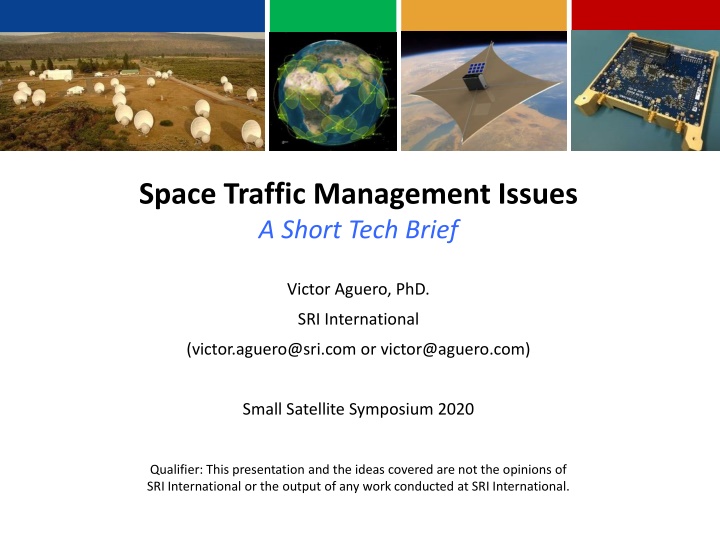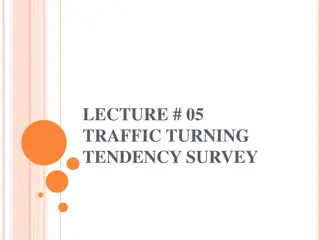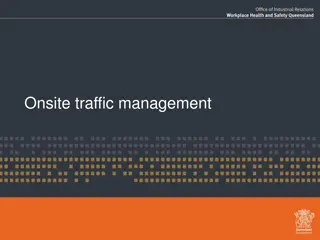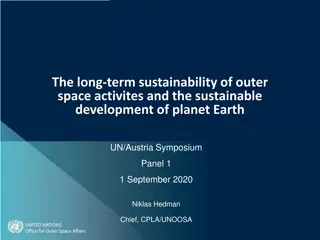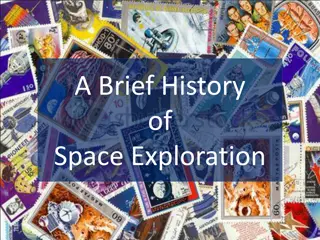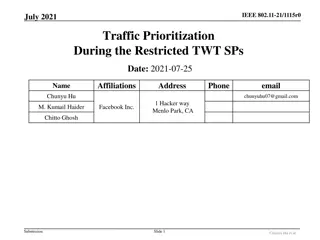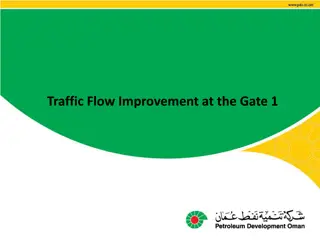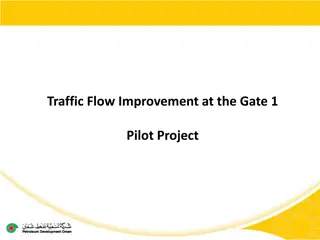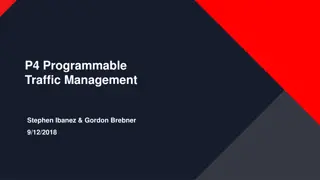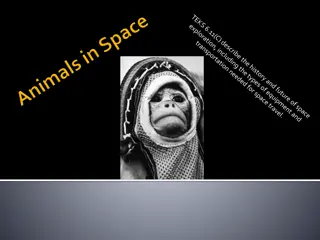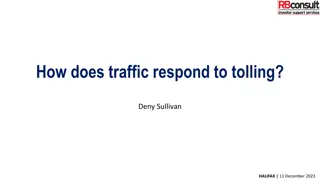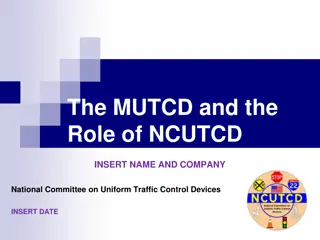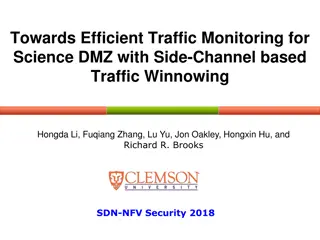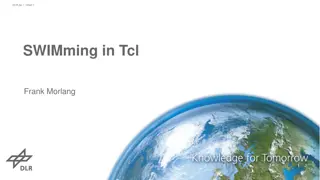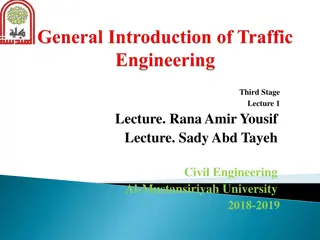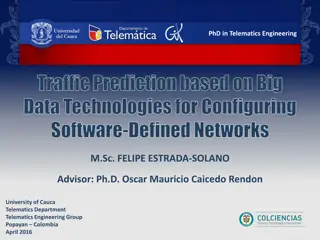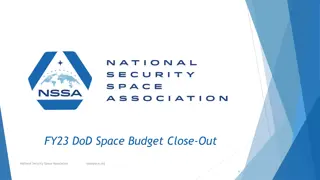Challenges in Space Traffic Management: A Tech Brief Overview
Space Traffic Management (STM) involves technical and regulatory provisions to ensure safe operations in outer space. Rapid evolution in space usage has led to concerns like collisions, debris, and increased object density, necessitating enhanced STM strategies and resources.
Download Presentation

Please find below an Image/Link to download the presentation.
The content on the website is provided AS IS for your information and personal use only. It may not be sold, licensed, or shared on other websites without obtaining consent from the author.If you encounter any issues during the download, it is possible that the publisher has removed the file from their server.
You are allowed to download the files provided on this website for personal or commercial use, subject to the condition that they are used lawfully. All files are the property of their respective owners.
The content on the website is provided AS IS for your information and personal use only. It may not be sold, licensed, or shared on other websites without obtaining consent from the author.
E N D
Presentation Transcript
Space Traffic Management Issues A Short Tech Brief Victor Aguero, PhD. SRI International (victor.aguero@sri.com or victor@aguero.com) Small Satellite Symposium 2020 Qualifier: This presentation and the ideas covered are not the opinions of SRI International or the output of any work conducted at SRI International.
What is Space Traffic Management (STM)? Wikipedia: The International Academy of Astronautics (IAA) defines it as "the set of technical and regulatory provisions for promoting safe access into outer space, operations in outer space and return from outer space to Earth free from physical or radio-frequency interference."[1] United States Policy: The Space Policy Directive-3 on 18 June 2018, defines Space Traffic Management (STM) as "the planning, coordination, and on-orbit synchronization of activities to enhance the safety, stability, and sustainability of operations in the space environment.[2] [1] Cosmic Study on Space Traffic Management. Paris: International Academy of Astronautics. 2006. p. 10. ISBN 2-9516787-5-4. [2] "Space Policy Directive-3, National Space Traffic Management Policy". White House. 18 June 2018. Retrieved 11 August 2018. 2
The Use of Space is Evolving Rapidly Traditional STM Focused on avoiding collisions and interference Involved government and large corporations More recently Accidents and undesirable things (e.g. debris) Iridium-33 - Cosmos-2251 collision (2009) Anti-satellite activities On-orbit explosions or propellant leaks Satellite Failures and disposal Natural objects (e.g. near earth asteroids) Maintaining custody Large scale launches (i.e. over 100 small sats) Mobility more maneuvers, non-impulsive Almost every country engaged in space activity Small developer / operators even high schools Example of Kessler syndrome creating a debris filled orbit. (Aerospace Report, Space Traffic Management in the Age of New Space , April 2018) OneWeb 3
Many Areas of Potential Concern Avoiding Collisions Uncertainty in object location covariance or uncertainty bubble in multiple dimensions Mitigation of collisions and debris generation Recovery post-collisions debris clean up Increasing Resources Dedicated to STM Cost and resources (exacerbated by 3D nature of the problem) Liability, Security, Attribution, Reaction time (at km/sec, reaction time could be in seconds to minutes) Increasing Density of Objects in certain orbits - constellations Very large numbers 100 s to 10,000 s per system , many systems New Sources of Objects: Manufacturing, Mining, Assembly, Repair, Servicing, Debris Removal, etc. New Patterns of Activity: Autonomy, Machine Learning, and AI Uncertainty Bubble (Aerospace Report, Space Traffic Management in the Age of New Space , April 2018) 4
Who Should Care and Why? Everyone! Governments Militaries very large investments Civilian Space Programs large investments, human activity Regulatory Agencies many issues to resolve, interests to satisfy Enforcement Agencies Legal ambiguities abound Commercial Business Investments and revenues are already approaching the ~$1T range Filings suggest in excess of 25,000 new objects in the next decade Consumers Anyone with a dependence on space (comms, navigation, television, etc.) Scientists, educators, space tourists Space forces Changes in activity are happening very fast! 5
Examples of In-space Traffic Categories Co-planar akin to well defined roadways or traffic corridors Relatively straightforward rules Crossing or Intersecting Orbital Planes akin to intersections Increased likelihood of collisions LEO satellites at the same altitude in crossing planes might pass each other >25,000 times in 5 years i.e. in dense planes of a constellation that might have 50 or more satellites/plane Highly desirable Orbits akin to congested highways Sun-synch, GEO, Molniya high traffic corridors, with many different users Work Sites complex traffic requiring active control (i.e. Air Traffic Control ) ISS, Cis-Lunar Gateway, etc (akin to airports and maritime terminals) On-orbit servicing In space assembly sites Launch concerns (object passing every 2 mins) 6
Significant Trends that Will Impact STM Constellations Large LEO Constellations, Mega-constellations Satellite Failures (5% of 25,000 is 1,250 satellites) Swarms 100 s in a cluster (traveling together) Many new launch providers access is opening up rapidly Cost is dropping substantially down to ~$5K/kg to orbit Improved Space Situational Awareness data and sharing Awareness of much smaller objects Greater opportunity for attribution Much greater mobility improvements are coming quickly Robotics Servicing, Assembly, Tele-operation In Space Manufacturing Production from raw materials in space Cyber threats 7
STM Must Address Many Issues Recognition, Planning, Action, International/Global in nature Affects every phase of space systems life Financing, design and development Launch and deployment Operations, maneuvers Replacement and Disposal Anomaly Resolution and post-event investigation Spectrum of object size small (mm-cm) to large (100 s m) Can we agree on standards tail-numbers , black-boxes , traffic management regulations (and corridors for traffic or norms), manuever requirements, coordination, etc. Can we come to agreement quickly enough? Some astronomers have pointed out that constellations create a light pollution problem. 8
What Surprises and Challenges Could Crop Up? Acts of God Legal and liability issues Operations in new regimes Attribution (Who assesses?) Dispute Resolution Offensive Activity Collateral Damage Clean up costs Autonomy, Machine Learning, AI Disposable vs. High Value Assets In Space Manufacturing In Space Mining Robotic Servicing Pirating Regulatory changes On and on 9
There is Hope Success in Other Domains There is a growing awareness of the inter-connected global value No one wants a war in space Discussion of helpful measures Beacons, transponders, tail-numbers Better tracking and data correlation Greater data sharing Commercial engagement ComSpOC In-space traffic management and custody systems Relaxation of some previously ITAR concerns (a US issue) Discussion of earlier de-orbit requirements Willingness to implement local SSA capabilities (like automated cars) The vast majority of participants understand win-win value of positive engagement and a growing space economy 10
STM Considerations or Recommendations Policy Related Global engagement, collaboration, and rationalization Establish clear norms of behavior Agree on responsibilities and penalties need consequences In US, decouple RF Licensing (FCC), Traffic Management and Launch regulation, and Environment concerns (e.g. US National Environmental Policy Act - NEPA) Near Term Actions of Value Continue improve data accuracy and sharing Begin active debris removal start with big stuff in dense orbits Require beacons, tags, transponders, tail numbers Track and register operators, not just objects 11
